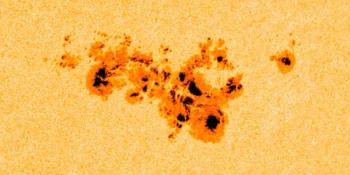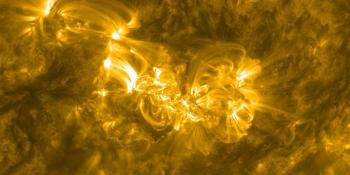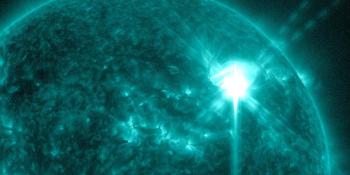Vaata pühapäev, 12 veebruar 2012 arhiivi
Päikese aktiivsuse aruanne
Any mentioned solar flare in this report has a scaling factor applied by the Space Weather Prediction Center (SWPC). Because of the SWPC scaling factor, solar flares are reported as 42% smaller than for the science quality data. The scaling factor has been removed from our archived solar flare data to reflect the true physical units.
Päikese ja geofüüsikalise aktiivsuse aruanne 2012 Feb 12 2200 UTCValminud NOAA © SWPC ja töödeldud SpaceWeatherLive.com-iga
Ühine USAF / NOAA päikese- ja geofüüsikaalase aktiivsuse aruanne
SDF number 043 Välja antud 2200Z kuni 12 Feb 2012IA. Päikese aktiivsete piirkondade ja päikeseaktiivsuse analüüs alates 11-2100Z kuni 12-2100Z Solar activity was low due to multiple C-class events
from new Region 1419 (N28E77) which rotated onto the disk as a
C-type group. This new spot group heralds the return of old Region
1402. New Region 1418 (S24E18) evolved on the disk as a B-type
group while new Region 1420 (S13E77) rotated onto the disk as an
H-type group. Region 1416 (S19W15) elongated along its axis and was
classified as an E-type Beta group. No Earth-directed CMEs were
observed during the period.
IB. Päikese aktiivsuse ennustus
Solar activity is expected to be low
with a chance for M-class activity, and a slight chance for X-class
activity, for the next three days (13 - 15 February).
IIA. Summaarne geofüüsikaline aktiivsus 11-2100Z kuni 12-2100Z
The geomagnetic field was at quiet levels. ACE solar wind speeds
were steady through the period at about 340 km/s. The Bz component
of the interplanetary magnetic field was mostly north with a 3-hour
period of southward Bz (-5 nT) from about 12/0600 - 0900Z. During
this 3-hour period, the phi angle switched from a positive (away) to
a negative (toward) orientation.
IIB. Geofüüsikalise aktiivsuse ennustus
The geomagnetic field is
expected to be at quiet to unsettled levels on day one (13 February)
due to coronal hole high speed stream effects. Late on day one and
through day two (14 February), field activity is expected to
increase to unsettled to active levels, with high latitude minor
storm intervals. This increase in activity is due to anticipated
effects from the 10 February CME. Day three (15 February) will see
a return of mostly quiet to unsettled levels as CME effects subside.
III. Sündmuste tõenäosus 13 Febkuni 15 Feb
| Klass M | 50% | 50% | 50% |
| Klass X | 10% | 10% | 10% |
| Prooton | 01% | 01% | 01% |
| PCAF | green | ||
IV. Pikklaine 10.7 cm kiirgus
Vaadeldud 12 Feb 110 Prognoositud 13 Feb-15 Feb 120/125/130 90 päeva keskmine 12 Feb 134
V. Geomagneetiline A-indeks
Vaadeldud Afr/Ap 11 Feb 003/004 Hinnanguline Afr/Ap 12 Feb 004/005 Prognoositud Afr/Ap 13 Feb-15 Feb 011/012-014/018-006/008
VI. Geomagnetilised aktiivsuse tõenäosused 13 Feb kuni 15 Feb
| A. Keskmistel laiuskraadidel | |||
|---|---|---|---|
| Aktiivne | 35% | 40% | 20% |
| Väike torm | 15% | 20% | 10% |
| Suur-tõsine torm | 01% | 05% | 01% |
| B. Kõrgetel laiuskraadidel | |||
|---|---|---|---|
| Aktiivne | 40% | 50% | 30% |
| Väike torm | 20% | 30% | 15% |
| Suur-tõsine torm | 05% | 10% | 01% |
<< Mine igapäevase ülevaate lehele
Viimane uudis
Viimane foorumi postitus
AR3664 667[CME] AR 13664, flare flurry, CMEs galore, 2024-05-08/09 175Is there any truth to this "Internet/Electrical Grid Apocalypse"? 97Unproven theories 399Weakening of Earths magnetic field due to geomagnetic excursion 19
Veel teemasidToeta SpaceWeatherLive.com-i!
Paljud inimesed külastavad SpaceWeatherLive lehte selleks, et jälgida, mis toimub Päikesel või, kas on oodata virmalisi. Suurema liiklusega on serveri koormus ning maksumus kõrgem. Kui sulle meeldib see, mida me sinu heaks teeme, siis saad sa sellele ka ise natukene kaasa aidata, annetades selle lehe käigus hoidmise ja arendamise heaks. Ette tänades SpeaceWeatherLive meeskond!

Fakte kosmose ilmast
| Viimane X-loide | 10/05/2024 | X3.8 |
| Viimane M-loide | 10/05/2024 | M1.3 |
| Viimane geomagnetiline torm | 06/05/2024 | Kp5 (G1) |
| Plekivabasid päevi | |
|---|---|
| Viimane päikese plekivaba päev | 08/06/2022 |
| Kuu keskmine päikeseplekkide arv | |
|---|---|
| aprill 2024 | 136.5 +31.6 |
| Viimased 30 päeva | 167.9 +77.8 |


